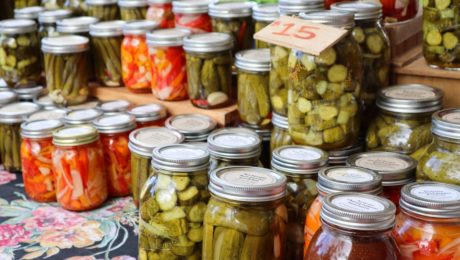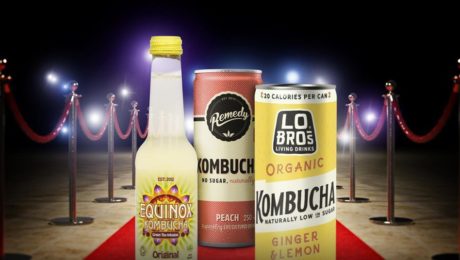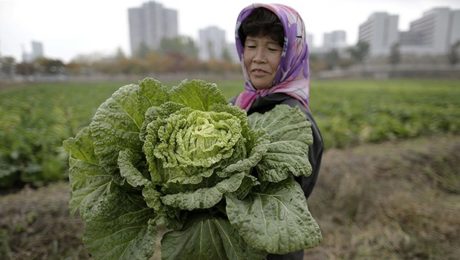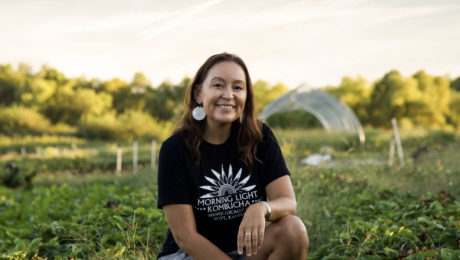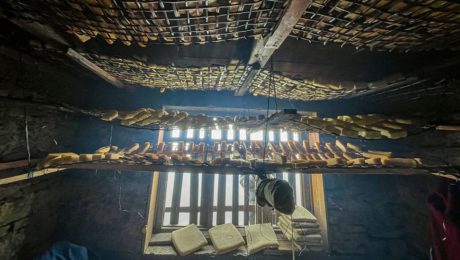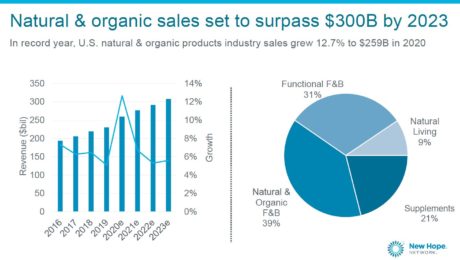Chocolate Without the Cacao
Cacao is one of the most environmentally harmful and ethically dubious commodities produced on the planet. It plays a huge role in deforestation, uses an alarming amount of water and more than 2 million children work in cacao farms. Yet cacao hasn’t been reimagined the way other foods with similarly harmful footprints have.
“There’s a lot of ethical quandaries around the production of chocolate,” says Johnny Drain, PhD, co-founder of WNWN Food Labs. “Cacao is a huge contributor to climate change, and child labor and slave labor are hardwired into the supply chain.”
Drain’s nickname is the “Walter White of fermentation” because of his work helping pioneering restaurants and bars around the world incorporate fermentation into their food and drink. Now Drain can add “Willy Wonka of chocolate” to his resume. He is co-launching a cacao-free chocolate, next in the wave of alternative products designed to replicate flavor and texture without a harmful production cycle.
A Chocolate-Potato Connection?
WNWN (Waste Not, Want Not, pronounced “Win-Win”) happened by chance. About five years ago, Drain was boiling old, green potatoes, and leaned his head into the steam. He was surprised it smelled like chocolate.
“I had this light bulb moment where I thought ‘There must be some compounds within the skins that are also found in cacao and chocolate.’ I wondered — ‘Could I make chocolate from potatoes? What other weird and wonderful things could make chocolate?’” Drain says.
WNWN plans to release a small-run batch of their chocolate next month. Drain and co-founder Ahrum Pak, a former investment banker and fellow fermenter-turned-food-activist, are calling the product category choc.
WNWN’s choc ingredients are proprietary until its formal release but, as with traditional chocolate, they are plant-based and fermented. Drain describes them as familiar, whole ingredients that are common in an average person’s diet.
“It’s not a Frankenstein, lab-created product, mixing this potion with that potion. We take whole ingredients, we ferment them just as we would chocolate, then we end up with this delicious chocolatey paste that goes into a quite conventional chocolate-making procedure,” Drain adds.
WNWN also replaces cocoa butter — made from cacao pods — with plant-based oils. Cocoa butter is what gives traditional chocolate a silky, creamy texture as it melts in your mouth.
Fermented Flavors
At the heart of choc’s flavor, though, is fermentation.
“Cacao is fermented to make chocolate in the same way our product is fermented. We use similar, friendly microbes to create complexity,” he says. “We’re recreating that flavour profile of chocolate that we all know and love using the same fundamental techniques that are used to make chocolate.”
High-quality chocolate contains roughly 600 different flavor and aroma molecules. Cacao fermentation involves lactic acid and acetic acid bacteria, along with various yeasts, to create its flavor.
“If you didn’t have that cocktail of microbes, you would end up with something that only tastes vaguely like the chocolate we know and love,” he adds. “At the heart of this is fermentation. The product that we have, if we produced it without the fermentation processes, it wouldn’t taste anything like chocolate, just like if you eat a raw cocoa bean or even a roasted, unfermented cocoa bean, it doesn’t really taste like chocolate. You have to have that very complex cascade of chemical reactions, made possible by the fermentation, to get the final chocolate flavour.”
The Next Big Alt Movement?
Drain is quick to point out WNWN is not the only company trying to create what he and Pak have coined “alt-chocolate.” Three companies — QOA, Voyage Foods and Cali-Cultured — all officially launched in the past three months.
Some of these companies have been operating in stealth mode for a number of years but made official launches once word of competitors began to circulate. QOA and Voyage appear to be using approaches similar to that of WNWN. CaliCultured is using a syn-bio precision fermentation route to modify yeast cells to produce lab-grown cacao cells that are genetically identical to those found in the wild.
Drain says he’s encouraged by the other companies.
“It’s exciting that there’s multiple people working in this space,” he says. “Look at the plant milk space or alternative protein space — there’s definitely plenty of room in this marketplace too, and collectively we are all doing this because we care about the ethical and environmental damage being wrought by the current cacao supply chain.”
European and American consumers historically dominate chocolate sales, but chocolate sales all over the world are increasing.
Drain and Pak feel that a shake-up in the industry at the top is needed. Huge international producers are responsible for the vast majority of global chocolate. Mars, Nestle and Hershey promised over 20 years ago to stop using child laborers, but reports say the problem continues.Similarly, these companies pledged a decade ago to source more sustainable chocolate, but negative environmental problems from cacao continue to increase.
“The way in which we consume food has to change. It’s unrealistic that millions of tons of mass-produced cacao is somehow ethically- and sustainably-produced,” Pak says.
Drain adds; “So, really, we’re not anti-chocolate, we’re anti-big-chocolate produced in unethical, unsustainable ways.”
Recreating Food
Chocolate is merely the first challenge that WNWN wants to address. Coffee and vanilla are next, foods with similar human rights and sustainability concerns. The company is building a software system that can ideate fermentation pathways for creating sustainable, flavour-identical analogs to delicious – but unsustainable – products.
“When you really start looking at how most of the world’s food is produced and consumed, there are so so many cases where it’s produced in a really terrible and damaging way,” Drain says. But “the market wouldn’t have been ready for a product like this five years ago. People are becoming much more aware of where their food comes from. People are thinking about ‘How do I make my purchasing habits, my diet better for the planet in a way that I don’t have to sacrifice the flavors and taste that I love?’ There will be work to do. But people are more receptive now that fermentation is more of a household name than it was five years ago. I think the fact that more people want to remedy these challenges is brillant.”
Drain will be speaking FERMENTATION 2021 on “The Alt-Universe”
- Published in Business, Food & Flavor
How Important is Consumer Education?
This is the second in a series of articles that TFA will be releasing over the next few months, analyzing trends from our Member Survey.
Fermentation is cloaked in mystery for many consumers — it’s bubbly, slimy, stinky and not always Instagram ready.
So how can fermentation producers appeal to potential consumers? What’s the best way to share fermentation’s flavor and health attributes?
In The Fermentation Association’s membership survey on industry trends, a better-educated consumer was identified as a priority. When asked what would foster increased consumption of fermented foods and beverages, the top item for nearly 70% of producers was greater consumer understanding of fermentation and familiarity with the flavors associated with fermentation.
“More than wanting to sell a product, I want people to know the information,” says Sebastian Vargo of Vargo Brothers Ferments (who is speaking at FERMENTATION 2021). The Chicago-based brand sells ferments like pickles, sauces and kombucha. “I believe preventative health starts with fermentation. I’m explaining the difference between a pickle you see on the shelf versus a pickle you see in the refrigerator. But I’m also teaching people to power up their pantry, sauce up their life with condiments.”
Health vs. Flavor
Producers say they struggle sharing fermentation’s benefits with consumers. There are not enough peer-reviewed scientific studies on many fermented products to be the basis for health claims.
“We feel a responsibility as a fermented food company to entice customers into trying these hugely beneficial and delicious products,” says Savita Moynihan, who owns SavvyKraut in Brighton, UK, with her husband Stevo. But, “with sauerkraut, it is generally understood that raw and unpasteurised kraut is good for you but once you try to elaborate on live culture vs probiotics it gets complicated, more than it needs to be.”
Can a brand claim to include probiotics? Producers feel that guidance is not clear.
“There is confusion here that we feel needs to be ironed out in order to loosen the reins so fermenters can promote their products and their benefits with much more confidence,” she adds.
Moynihan says that, when SavvyKraut sells at farmers markets and local shops, they try to communicate two main things to consumers. First, the health benefits, like enhanced vitamin and nutrient contents, increased fiber and an aid to a diverse gut and digestive system. Second, the delicious flavor.
“The process of fermentation really enhances the flavours and creates an entirely new type of flavour which can elevate any meal,” Moynihan adds.
Lack of Tastings Hurting Efforts
One of the best ways to familiarize consumers with fermentation is for them to taste a product — flavor is a great marketing tool. But COVID-19 has hurt these efforts. Producers are unable to stage in-store demonstrations, offer samples at farmer’s markets or host in-person events. This has been especially hard for kombucha brewers, says Hannah Crum(who is also speaking at FERMENTATION 2021), president of Kombucha Brewers International (KBI).
“We still have such a big part of the population who don’t drink kombucha or don’t even know about [it]; we still have a lot of work in education,” Crum says.
Joshua Rood, CEO of Dr Hops Hard Kombucha, confirms, adding: “It continues to be very difficult to grow our brand and the whole category without live events.”
“The inability to do live tastings in 2020 had a significant diminishing impact on our sales during the pandemic,” he continues. “One of our main distinctions as a brand is superior taste. Consumers, however, do not believe claims about that unless they experience it for themselves. Even now we are significantly hampered by the lack of large beer festivals and street fairs. An artisanal craft brand like Dr Hops needs those live interactions!”
The Knowledge Gap
Despite the lack of in-store tastings, experts at New Hope Network (producers of the Natural Products Expos) say brands have a great opportunity — now, more than ever, during the COVID-19 pandemic — to connect with their consumers.
New Hope’s 2021 Changing Consumer Survey found U.S. consumers are not satisfied with their current health. Only 8% say they’re “extremely satisfied” with their health today, compared with 20% in 2017. Nearly 80% of consumers understand that diet greatly influences their health (79%). But achieving good health is both a goal and a struggle for consumers — and this is where brands can step in.
“There’s a gap to be bridged,” says Eric Pierce, vice president of business development for New Hope Network, during a session “Understanding Your Consumers” at the most recent Expo East. “I see it as our opportunity and our responsibility to help consumers translate healthy intentions into healthy behavior, either in how we’re educating them in our stores, the products that we’re innovating or the ways we’re communicating. Getting better at communicating can help them with solutions.”
A consistent, transparent, well-communicated message — from product label to social media page to website — is important. Pierce says consumers quickly see past “shallow marketing claims.”
“Leave a trail of breadcrumbs people can find,” Pierce advises. “You don’t have to communicate everything all at once, but allow people to follow a trail to the deeper story. When consumers want to find that trail, if it’s not there, they’ll quickly write you off as shallow with unbacked claims.”
Amanda Hartt, market research manager at New Hope, suggests putting a QR code on a product label that links to the science backing the benefits of your ingredients. Or partnering with a registered dietitian on social media to highlight how to use your product as part of a healthy diet.
[To learn more about this topic, register for FERMENTATION 2021 to hear one of the keynote panels “Educating Consumers About Fermentation.”]- Published in Business, Food & Flavor, Science
“A modern-day Johnny Appleseed”
GQ interviews “The Godfather of the Fermentation Revival,” Sandor Katz. In the Q&A, Katz shares how a cabbage surplus in his first garden turned into an obsession with fermentation. Katz teaches fermentation workshops and gives fermentation talks around the world (he will be speaking at FERMENTATION 2021). He’s also now the author of six books on fermentation, including the recently-published Fermentation Journeys.
The article says Katz “has become a globe-trotting mascot for the power of bacteria and yeast to create delicious food, a kind of modern-day Johnny Appleseed of tangy, savory flavors.”
Katz shares how he’s interested in learning more about the Chinese techniques for fermenting vegetables; he believes China is where fermenting vegetables in salt first originated. He also addresses his misquoted healing. Katz has lived with H.I.V for more than 30 years, but he says eating fermented foods does not cure AIDS. Katz does believe he’s never been sick from the antiretroviral drugs he takes to manage the disease because he eats fermented foods regularly.
Read more (GQ)
- Published in Food & Flavor
Craft Kombucha Battles Big Brands
A group of craft kombucha brewers are banding together to fight industrialized kombucha. These small, UK-based companies say a number of big players are entering the kombucha space but taking mass production shortcuts, like pasteurizing and adding sweeteners. Many of the bigger brands, they say, are “kombucha in name only” making lab-engineered fermented tea without the fermentation.
“They don’t have time to ferment, some of them just use an instant mix, which totally goes against the grain of what kombucha is,” says Gary Leigh, founder of Go Kombucha and who that is leading what they’re calling the Real Kombucha Revolution. “Some make the kombucha, pasteurise it, kill off all the natural bacteria and add their own in.”
This consortium of craft brewers says mass-produced kombucha is edging out smaller, authentic brands. Craft brewers are struggling to compete when bigger companies are selling cheaper “kombucha” with a longer shelf life. Many consumers don’t realize what they are buying. Leigh stresses they’re not anti big kombucha brands, they just want brewers to be transparent about their production methods – they need to note on their labels if they’re pasteurized and/or they use sweeteners.
Read more (The Grocer)
TAGS:
- Published in Business, Food & Flavor
Cabbage Shortage Forces Halt in Winter Kimchi
A cabbage shortage is forcing North Koreans to give up winter kimchi making for the second year in a row. They are unable to take part in gimjang, the Korean tradition of communally preparing kimchi each October for the winter season.
Flood damage and poor crop yields led to a poor cabbage (and radish) growing season. The cabbage that was harvested was mostly routed to military and government agencies, “leaving the people empty handed.” Cabbage prices have risen 25% from a year ago, “making a large batch of kimchi cost more than a government-provided monthly salary,” according to Radio Free Asia.
Read more (Radio Free Asia)
- Published in Business, Food & Flavor
Q&A: Melinda Williamson, Morning Light Kombucha
Melinda Williamson has always been fascinated by plants — she grew up watching her mother make baby food with produce from the garden, later studied medicinal plants in college and dedicated her career as an ecologist to researching microbial communities in soil.
So, when Williamson became extremely sick with an autoimmune disease eleven years ago, it was not surprising that she turned to plants. She began making green smoothies daily and, after a student shared a bottle of it with her, drinking kombucha.
“I became really conscious about what I was putting in my body, really focusing on where my food was coming from,” says Williamson, founder of Morning Light Kombucha in Hoyt, Kansas. “I started researching my illness, and found that a lot of stuff stems from the gut. It brought me into this world of ferments.”
The health-scare-turned-health-revival changed the course of her life. Mother of a then-young child, Williamson moved back to Kansas to raise her daughter closer to family. She took a language program job on the Prairie Band Potawatomi Nation reservation in her hometown, then spent her hours off work fulfilling a dream of running her own business. She perfected a home-brewed kombucha and began selling it at local farmers markets, gas stations and yoga studios.
The pandemic easily could have shuttered a small brewery like Morning Light which, prior to 2020, Williamson ran on her own. But she designed a website, opened an online store, started curbside delivery and launched a canned line — and sales grew by 25%. By the end of 2021, Morning Light Kombucha will start shipping nationally and, by the end of next year, they plan to break ground on a 4,000-square-foot facility on the reservation.
“What I really want to do is get my product into more native communities, so they can find healing just like I found healing,” says Williamson, head of the only Native American kombucha brand. “That’s more important to me than seeing my product on the shelf of Wal-Mart or Target. I’m not in it to be rich. I still plan on living in my little house here on the reservation close to my family. I just want to do something that has meaning and an impact.”
Below is an edited Q&A between Williamson and The Fermentation Association.
TFA: Where do you get your ingredients? You forage some of the ingredients yourself on the reservation.
MW: We go out and harvest wild blackberries, wild raspberries, chokecherries and pawpaws mostly on the reservation. There’s edible plants everywhere, it’s surprising the places you can find them. We just went to Overland Park, which is the city near us, to forage for pawpaws.
Some of the ingredients like gooseberries, those we find in small quantities. If we go out and we only get four cups of berries, we may not make any kombucha with it. But sometimes I’ll make a little five gallon batch.
Most of our ingredients, we partner with local farms in Northeast Kansas. It comes down to the importance of knowing where our food comes from. My goal was to always work with local farmers and source ingredients locally, I knew I wanted that as part of my business foundational value.
As much as possible, we keep sustainability at the forefront of everything that we do, being really conscious about our footprint. It’s really nice because, being in Northeast Kansas, people aren’t thinking about stuff like that. They’re more and more thinking about where their food comes from, but it’s been really nice to have those conversations with the community and get people really thinking about supporting the local farming economy, supporting local business.
A big part of it really comes down to what we’re showing our kids. Before my daughter was born, I had her when I was 23, I was eating a lot of fast food. I was like “I’m free! I’ve got a job! I can buy and eat whatever I want!” I was eating so much junk food. And then I got pregnant and wanted to feed her properly. I grew my own garden and started making my own baby food, just like my mom modeled for me. Food is so important, it’s a constant conversation in my life and in my business.
TFA: Do you make seasonal flavors then?
MW: We launched our canned kombucha line in February. Prior to that, we were doing about 100 flavors a year, so now that we’ve launched our canned kombucha line, we’ve had to whittle that down because we have to have four flavors constantly. Our rotations have diminished a little, but we’re still putting out about 60 flavors a year.
Our berry flavors are our most popular — blackberry lemongrass and strawberry. Seasonally, our smaller batches that people love are mulberry, that is a top seller. People also love the ginger and chokecherry flavors.
TFA: How do you sell your small batches? Are you selling them retail or filling kegs on site?
MW: We sell direct-to-consumer, like at the farmers markets and events. We don’t have a brewery that’s open to the public. We do curbside pickup, that was something that was developed in response to the pandemic. We could no longer sell directly to the consumer, so we just started doing doorstep delivery, then the curbside pickup. Basically, people just have their empty bottles in their trunk and call us and we come out and grab their bottles, and swap them for new, filled bottles. It’s contactless, but we still got to see our customer and wave. We’ll probably continue to do that, we’re still in this pandemic, and the most important thing is to keep our community safe and our elders up here safe. We will continue taking all precautions to protect people around us until we hit a safe spot.
TFA: A portion of your sales goes back to the native communities. Tell me about that.
MW: We donate where we feel like the money would be used best, things that we’re passionate about and things where we see we can make a difference. For example, we just recently donated to one of the residential school survivor nonprofits. We’ve taken clothes to Standing Rock Sioux Tribe where they were protesting the Dakota Access Pipeline, we’ve donated to our Boys and Girls Club here on the reservation, we’ve donated to our youth soccer teams, we’ve donated to First Nations programs in Canada.
TFA: Morning Light Kombucha is a trademark American Indian Food product. What does that mean?
MW: So that trademark American Indian Food falls under the Inter-Tribal Agricultural Council, which is a subset under the USDA. The program really highlights American Indian food producers. You apply and then the program supports you in different ways. We’re able to network with other American Indian food producers, brainstorm together and talk about what we’re experiencing and try to make movements when it comes to distribution. The program is really big with international exporting, so all the American Indian food producers have the opportunity to attend large trade shows internationally, they’ll fly us there, ship our products and give us the opportunity to have a booth and get our product in front of people who are interested in American Indian food products. I’m not ready for something that big, I am so small, but I’ve gone to a domestic show through the program. I went to a food show in Chicago and got in front of a lot of people who are interested in my kombucha. We have really big plans in 2022 to expand our facilities, and hopefully expand domestically.
TFA: What are Morning Light Kombucha’s plans for 2022?
MW: I just bought 10 acres here on our reservation. My plan is to break ground and build a production facility. It will be three times the size of what we’re in now, which will be really, really nice. There’s a pond on the side, we’ve got a creek, timber, a lot of foraging areas. The plan is to build an off-the-grid brewery, too, so it will help us provide more jobs in our community and it will allow us to do some of the things that we haven’t been able to do.
I mentioned sustainability is a big part of what we do. We compost 100% of our brewery waste, but I have to truck it to my house to my compost pile because, where we’re at now, we just can’t compost large quantities at our site. The waste water from our water filtration system, it’s totally usable water, but we don’t have any place to store it currently. Our waste water is not like gray water, it’s clean water that’s just wasted during the filtration process, it’s usable. For every one gallon that’s filtered, there’s three gallons that’s wasted. It’s so insane, it killed me when I found that out. Once we are in our new facility we can begin to recycle it on property. We have this dry pond. Our plan is to see if we can get it lined, divert the waste water in there and start filling the pond.
TFA: Scaling will be big for you in 2022.
MW: I know, I just hired three employees recently because it’s just been me for the past few years. I work part-time for our language department, and my kombucha business has been my side hustle. In the past year, I’ve realized the potential. People really like my brand and they’re noticing it and requesting it. So I thought “Maybe I could grow this brand into something bigger.”
TFA: I am beyond impressed — you have been building a kombucha brand by yourself?!
MW: Family is always there for me. My boyfriend is at the market, my nephews help with anything I need, it’s a family affair even though I never really had anybody on my payroll until recently. Now I’m getting to a point where I need help all the time. I hired my sister as my brewery manager, she keeps a tight ship. It’s allowed for me to really work on expansion while she’s running operations at the brewery.
TFA: Yours is still the only Native American-owned kombucha brand.
MW: With my business, I like to think that I’m also giving a voice to native issues. I would never want to be an authority on native issues, but there’s a lot of things going on in Indian country that people don’t see in the mainstream media and mainstream social media. If I can build a brand that can also bring awareness to these things, that’s really important to me.
TFA: You have a background in academia. What got you interested in ecology before switching to kombucha?
MW: I’ve always loved science, I’ve always loved the outdoors, I’ve always been super eco-friendly, I’ve always been conscious about our impact on the earth. I love animals, I love nature. I was taking some of my general ed classes at Haskell (Indian Nations University) and took an ethnobiology class. I just fell in love. I ended up transferring to Kansas State and got my degree in environmental biology (then a masters degree in rangeland ecology and management from Oklahoma State University.) I went with my boss from K State to Oklahoma State and ran the grassland ecology lab for years.
TFA: Where do you see the future of fermentation?
MW: There’s an explosion. I see it continuing to grow and expand and people are coming out with really innovative ways to bring fermentation to the table. Like Wild Alive Ferments out of Lawrence, Kansas. We’re a part of a local CSA with them. The owners just came out with an apple kraut flavor, an autumn harvest with spices that is so amazing.
In the U.S. especially, we have a lot of people who are sick with illnesses or cancers and autoimmune issues and I think we’re starting to see more people look at what they’re putting in their bodies. They’re realizing the importance of gut health, the importance of ferments, and that it affects so much more than just your gut. It’s a movement — and I’m really excited about it.
- Published in Business, Food & Flavor, Health
Primeval Poop Profiles
Studies of ancient poop found “humans as long as 2,700 years ago in the Iron Age were already using sophisticated techniques in flavoring the fermented foods.” They especially loved pairing pale ale with blue cheese.
A paper published in Current Biology detailed how researchers used paleo fecal samples found in salt mines in Austria to analyze the food ancient people were consuming. Their stool dehydrated in the salt, creating an ideal, preserved sample.
Researchers from the Institute for Mummy Studies, the University of Trento and the Vienna Museum of Natural History also found industrialization transformed the Western diet. Humans used to have healthier, more biodiverse gut microbiomes “because they were eating unprocessed foods.”
Frank Maixner, one of the paper’s lead authors, believes combining archaeology and microbiology could “illuminate the greater puzzle of human history.”
Read more (Popular Science)
- Published in Food & Flavor, Science
Chhurpi — Cheese from Chauri
Have you heard of chhurpi, the world’s hardest cheese? Developed thousands of years ago in a remote Himalayan village, it’s made from milk from a chauri (a cross between a male yak and a female cow) and is a favorite snack in pockets of eastern India, Nepal and Bhutan.
The protein-rich, low-fat cheese gets softer the longer it’s chewed — and people will chew on small cubes for hours. Chhurpi has low moisture content, making it edible for up to 20 years. It’s used in curries and soups or chewed as a snack (especially by yak herders during their long travels).
Chhurpi is fermented for 6-12 months, then stored in animal skin. It’s healthy and nutrient-rich, as chauri graze on herbs and grass in the high alpine mountains.
“It is said hard chhurpi takes anything between minutes to hours to soften, after which it tastes like a dense milky solid with a smoky flavour as it dissolves slowly. The so-called world’s hardest cheese is admittedly not everyone’s cup of tea, and I never could bite into one so far, but Nepalis across the country adore it,” writes BBC writer Neelima Vallangi.
Read more (BBC)
- Published in Food & Flavor
The Forefront of Alt-Proteins in Africa
Price and regulation are big roadblocks for alternative proteins, an industry that is expanding rapidly, as more consumers turn to animal-free products out of concern for their health, the environment and animal welfare.
“People love meat but, at the end of the day, they’re not really attached to how it got to their plates,” says Brett Thompson, co-founder and CEO of Mzansi Meat, a cultivated meat company in South Africa. Thompson spoke at the TFA webinar The Forefront of Alt-Proteins in Africa with another leader in the South African alternative protein industry, Leah Bessa, PhD, co-founder and CSO of De Novo Dairy.
Alt-protein companies all over the world are bringing cultivated meat and dairy to consumers, but Africa as a continent has lagged.. Thompson founded Mzansi Meat Co. in 2020 and hopes to bring cell-cultured beef, chicken and braai sausages (traditional South African BBQ-style sausages) to retail shelves next year. De Novo Dairy, formed in 2021, is using precision fermentation to create milk proteins for animal-free dairy products, but without cows.
This novel biotechnology is new in South Africa, but it’s a critical element in addressing food security problems in Africa. Africans don’t consume enough food, especially protein, and as drought continues to plague the continent, raising animals for traditional meat products is becoming less and less sustainable.
“It’s a very different conversation to the rest of the world,” Thompson adds. “It’s about getting more protein into more people’s stomachs and plates.”
Big Production Costs in New Alt-Protein Space
Interest is high from investors, but scaling from pilot stage to large-scale production is challenging. Equipment is costly and labor is difficult to recruit to a new industry.
In a survey conducted by Mzansi, 50% of South Africans were willing to purchase alternative protein products — and they’d pay a higher price than for traditional meat.
“But we just got to make it available,” Thompson says. “That’s going to be the biggest hurdle for us, getting it into retail and getting it in front of people so that they can make that decision.”
Bessa says that, critical to the adoption of animal-free dairy, the consumer must receive “nature identical” products. These must replicate the taste, texture and nutrition level of traditional dairy — and precision fermentation is a “powerful tool” to helping achieve that goal.
“It’s going to be a very easy sell,” Bessa adds. “What’s really great about precision fermentation is, as a technology, it’s not limited to just one or two proteins. You can really explore other functional elements and other functional proteins across the food industry. So we’re really looking beyond just dairy, but we want to solve a big problem in the dairy industry because it’s very unsustainable.”
The Good, the Bad & the Ugly — of Government Regulation
Bessa notes regulation is a bigger challenge than technology for De Novo. Three governmental bodies in Africa oversee food production — the departments of trade, health and agriculture. Mzansi is exploring launching in food service, as an alternative to the long, arduous process of securing government approval to sell a product at retail.
“Consumers want something that’s familiar but, now with regulatory hurdles, if you have to classify and label them differently, then how familiar would that label be to consumers?” says Josephine Wee, assistant professor of food science at Penn State University (and a TFA Advisory Board member). Wee moderated the discussion with Thompson and Bessa. “I think it’s an important conversation as well because it might be confusing if it tastes just like milk but is labeled completely different.”
Transparency is a priority for both Mzansi and De Novo. Thompson says companies preaching sustainability can’t be “cagey…or you send out messages that are convoluted.” Bessa agrees, noting a young company may never recover from bad publicity over transparency issues.
“Working with new technologies, especially in food, which is such a personal thing for people, you almost want to get ahead of assumptions, you want to be the one putting out the information and the correct information,” Bessa says. “That’s why it’s so important because you’re working with a novel technology, you’re feeding people with this novel technology, and so it’s important to be transparent so that they feel comfortable and they can relate to what they’re consuming.”
- Published in Business, Food & Flavor
Natural & Organic Sales Growing but Slowing
Sales of natural and organic products grew nearly 13% to $259 billion in 2020 , “despite the pandemic and, in some ways, because of the pandemic.”
“It’s very strong and, in many ways, it’s never been stronger,” says Carlotta Mast, senior vice president of the New Hope Network (producers of the event). Between pandemic-driven pantry loading, new brand exploration and the drive to purchase healthier, natural products, “people tried those new brands and, in many cases, they stuck with them, especially across the food and beverage categories.”
Mast shared these stats during the State of the Natural & Organic presentation at Natural Products Expo East. But forecasts show sales growing at a slower pace this year, to $271 billion. By 2023, sales are projected to surpass $300 billion.
Natural foods and beverages (including most fermented products) account for 70% of all natural product sales (the rest includes items like supplements and home and pet care products). Natural products are growing three times as fast as their mainstream counterparts.
“Not only were we growing quickly, we were outpacing the rest of the store…not only did our sales accelerate, they drove the whole (food) industry forward,” says Kathryn Peters, executive vice president at SPINS (a data provider for natural, organic and specialty products). “We’re finding consumers are coming and staying and continuing to buy more.”
Expo East Returns In-Person
Expo East is the first major food trade show to meet in-person since the Covid-19 pandemic shuttered events in March 2020. New Hope Network used a hybrid virtual and in-person model to produce the show, live-streaming the conference portion to virtual attendees.
“It was really exciting and satisfying to be back on a live show floor, interacting with people again. There was a real buzz,” says Chris Nemchek, TFA’s buyer relations director. “On day 1, you could tell there was a lot of pent-up demand.”
Health precautions were increased. Attendees had to show a Covid-19 vaccination card or a negative Covid-19 test administered within 72 hours. Masks were mandatory. Badges were no longer distributed to all attendees, only being printed upon request.
Food sampling, too, was much different than at a typical pre-pandemic trade show. Samples were only given by a gloved brand representative at an exhibitor’s booth. Food was stored behind sneeze guards, and surfaces were wiped down frequently.
“Exhibitors gave away less product, but the product they did give away was for more productive reasons — the people who took the sample really wanted it,” Nemchek notes.
“It was a good step back towards normal, but it wasn’t normal,” he adds. The size of the crowd at the show was not close to pre-pandemic levels (attendance numbers have not been released). But Nemchek notes that New Hope should still be pleased. “There’s now more confidence in the industry in putting on a food show again.”
Immune Health Driving Purchases
The natural and organic industry’s most popular products continue to be ones supporting immunity, health and wellness. Those attributes were consumer’s top purchase priorities in 2020, and remain strong in 2021.
Paleo (+25%), grain-free (+17%) and plant-based (+13%) foods and beverages registered the strongest sales growth. Plant-based products have seen especially strong sales over the past two years.
“Covid was a major driver for this boost in sales growth,” Mast says. Now “it’s our opportunity to keep those consumers.”
Consumers are exploring how they can use their diet as the first line of defense against illness, Peters adds. Immunity-related ingredients traditionally found on the supplement aisle, like cider vinegar, collagen, elderberry, moringa and ashwagandha,are now in grocery and refrigerated products.
“It’s revolutionizing the aisles in the store,” Peters says.
Changing Grocery Store Shelves
The U.S. is diversifying faster than predicted as well, and those demographic changes are influencing what’s selling. International foods are outperforming in grocery sales, growing at a 21% rate (compared with U.S. food at 16%).
“This is a huge shift for our country,” Mast says. “We’re seeing that, across our industry, more consumers are looking for that multicultural food.”
Mast notes, though, that leadership of the natural and organic products industry does not reflect the U.S. population.More BIPOC representation is needed on i company boards and leadership teams.
Shopping with Values
Consumers’ social and environmental values are also driving purchasing behavior. A survey by Nutrition Business Journal and SPINS found 76% of natural shoppers pay more for high-quality ingredients, 57% avoid buying food grown on industrial feedlots or chemical-intensive farms and 53% will pay more to support businesses that are socially- or environmentally-responsible. Consumers want companies to take social and political stances that reflect their own values.
“Our industry, because of our size, our scale and our influence, we could truly help create solutions to these problems and be part of building that new future,” Mast adds. “Think about the changes that we could help create for people, animal, planet — but it’s if we chose to do so.”
- Published in Business, Food & Flavor


